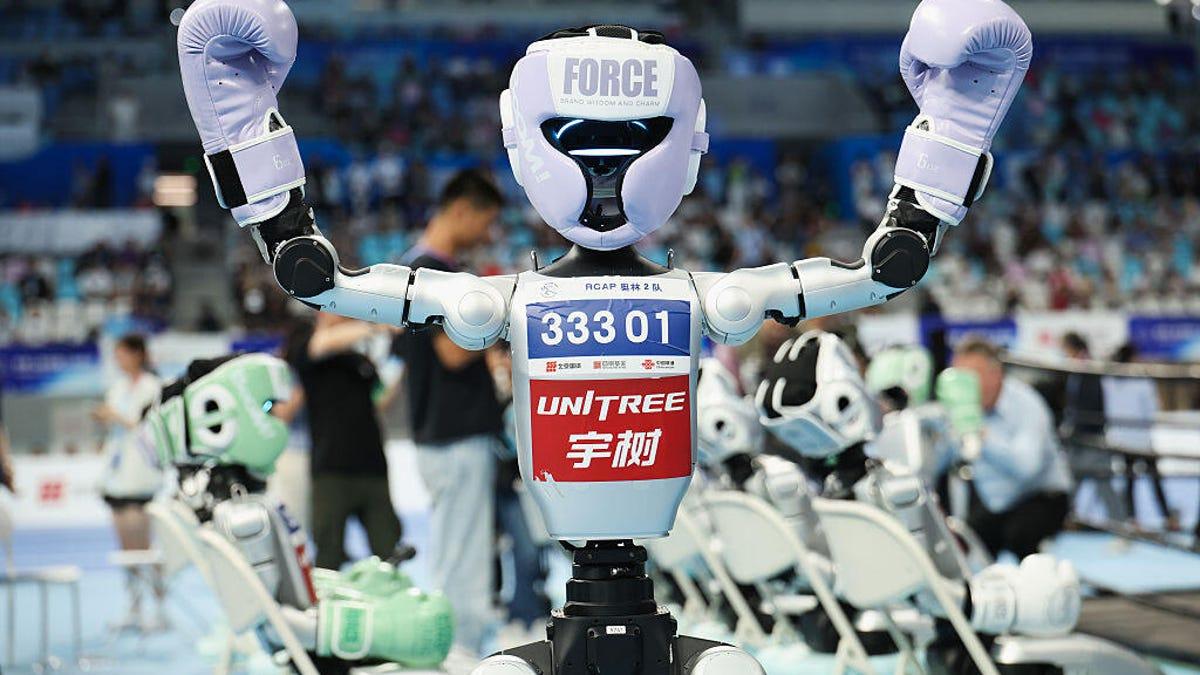World's First Human vs. Robot Half-Marathon: China Pushes Boundaries in AI and Robotics
4 Sources
4 Sources
[1]
Human vs: humanoid: Half-marathon pits robots against 12,000 joggers
Runners completing a half marathon in Beijing later this year will do so with some unusual, metal competition at their sides. According to a press release from China's Beijing Economic-Technological Development Area, more than 12,000 human runners will square off against dozens of bipedal, humanoid robots from more than 20 companies in a 13-mile course. The top three finishers, be they human or humanoid, will receive prizes. But the robots will have their work cut out for them. As of now, no bipedal robot has successfully completed that long of a race, let alone against a seasoned human runner. The announcement was first spotted by the South China Morning Post. [ Related: Why animals run faster than their robot doppelgängers... for now ] There are some requirements the robot joggers will have to meet. For starters, they will need to look vaguely human. That means two legs and a mechanical structure capable of carrying out bipedal functions like upright walking and running. These guidelines rule-out high-functioning quadruped robots like Boston Dynamics' Spot or KAIST's RAIBO2, which completed a full marathon last year in just over four hours. Wheels also aren't allowed. In terms of size, E-Town says the humanoid should measure between 1.6-6.5 feet tall with a maximum extension from their hip joint to the foot sole of at least .45 meters. Importantly, the robots won't need to be fully autonomous to compete. Teams are allowed to remotely operate their machines, which could come as welcome news if Tesla decides to send its Optimus bot to the race. Humanoid robots have already proven capable of running, sometimes quite quickly. Last year, a team of engineers from Oregon State University created a bipedal, though not human-looking robot that set a Guinness World Record for the fastest 100-meter dash performed by a machine. In China, humanoid robots from the companies Robot Era and Unitree Robotics can reportedly reach top running speeds of eight miles per hour and 7.38 miles per hour respectively. Tiangong, a humanoid robot created by Beijing Humanoid Robot Innovation Center actually made an appearance at the finish line of a half marathon last year, but it didn't complete the entire course. Still, none of these robots come close to matching human sprinter Usain Bolt's record top speed of 27.33 miles per hour. [ Related: Oh good, the humanoid robots are running even faster now ] Outside of events like these, humanoid robots are mostly being designed with two primary use cases in mind: manufacturing and caretaking. Chinese humanoid robots have already reportedly been deployed at BYD car factories, though it's unclear exactly how much work they are actually complete. China isn't alone on that front. Last year, BMW announced it was recruiting a humanoid robot from Figure AI to work in its South Carolina manufacturing facility. Tesla CEO Elon Musk, meanwhile, has also suggested the company's Optimus robots could one day work alongside humans to build future electric vehicles. For now, though, Optimus in particular seems best equipped at fondling eggs and performing cranking out light calisthenics. But the April race might not be all for show either. Government-backed challenges and competitions have a history of fostering research innovations down the lines. An example of that played out during DARPA's 2007 "Grand Challenge" when the agency had some of the top engineering minds at the time face off head-to-head to create an autonomous vehicle capable of driving itself through a desert. Autonomous vehicle experts previously told Popular Science that the results of that challenge attracted the attention of Google co-founders Larry Page and Sergey Brin and planted the seeds for what would eventually become Waymo. It's possible one of the running robots in Beijing could follow a similar tract. Or, they could also fall flat on their faces. Either way, we'll be watching with interest.
[2]
China to Pit 12,000 Humans Against Robots in World's First AI Marathon Race - Decrypt
Are you a marathon runner? AI is coming for your job, too. China is organizing what could be one of the weirdest races in history: a half-marathon where 12,000 humans will compete against an army of humanoid robots to see who's the best long-distance runner. The 21-kilometer race in Beijing's Daxing district isn't just another tech demo. More than 20 companies are bringing their best walking robots to compete, and they're playing for real money -- the top three finishers get prizes regardless of whether they're made of flesh or metal. This would be the first time humanoid robots race a full 21-kilometer course. Last year, robots were able to join a race without having to complete the full route. The Beijing Economic-Technological Development Area (E-Town), which is organizing the event, includes a strict no-wheels policy, and the bots actually need to look human-ish and walk on two legs. They need to be between 0.5 and 2 meters tall -- so no giant mechs or tiny robot cars will be sneaking in. One of the early favorites is Tiangong, a humanoid that can run 10km/h. The robot, developed by China's Embodied Artificial Intelligence Robotics Innovation Center, already showed up at last year's Yizhuang Half Marathon. However, this will be its first shot at running the full course. It also crossed the line alongside some of the fastest humans during last year's half marathon -- after joining for the last 100 meters. It's not like Americans are focusing on building super fast humanoid robots. The hype around AI and humanoid robotics is more present than ever in China. Local companies installed 276,288 robots in 2023, accounting for 51% of global installations, according to the International Federation of Robotics. The industry is projected to hit 400 billion yuan ($54.6 billion) by 2030. E-Town's not just organizing races -- it's already got robots working at Chinese BYD's electric vehicle factories. After this marathon, Beijing's planning another robo-sports showdown in August, featuring everything from track and field to football. The organization also plans to invest 60 billion yuan ($8.21 billion) in AI developments this year.
[3]
China: 12,000 humans to race humanoid robots in world-first marathon
The humanoid robots, developed by companies from around the globe, will take to the streets alongside 12,000 human runners. The robots will run the entire race for the very first time this year. This unprecedented race reflects China's ambitious push to become a global leader in artificial intelligence and robotics Reportedly, this first-of-its-kind race will see humans and robots challenge themselves on a 13-mile (21km) route. The top three runners will receive prizes. As per the Beijing Economic-Technological Development Area, companies, research institutions, robotics clubs, and universities worldwide will participate in the marathon with their humanoid robots. A key requirement is that the robots must possess a human-like appearance. Moreover, they should be equipped with a mechanical structure that allows them to perform movements such as walking or running on two legs, excluding wheeled locomotion. The humanoids must also be between 0.5 meters and 2 meters (1.6 feet and 6.5 feet) tall. Remotely controlled and fully autonomous humanoid robots are eligible to participate in the marathon. Furthermore, battery replacements are permitted during the race.
[4]
World's first human-robot race: 12,000 runners to compete with robots this April. Check eligibility, requirement, prize
Beijing is set to host the world's first-ever human-robot marathon in April 2025, where participants will race alongside humanoid robots. The 21km event will feature both human runners and robots, highlighting China's advancements in robotics and artificial intelligence. This groundbreaking marathon, set in Beijing's Daxing District, aims to push the boundaries of human-robot collaboration and showcase the potential of robotic technologies in real-world applications. History is set to made this April as China will be hosting the world's first human-robot marathon in Beijing's Daxing district. This half-marathon will feature 12,000 human runners competing alongside humanoid robots, marking a groundbreaking integration of advanced robotics in sports. Prizes will be awarded to the top three finishers, regardless of whether they are human or robot, as reported by the South China Morning Post (SCMP). Organized by the Beijing Economic-Technological Development Area, also known as E-Town, the marathon will showcase robots developed by over 20 companies. The primary requirement is that participants must resemble humans and have a mechanical structure capable of bipedal walking or running -- robots on wheels are not permitted. According to the guidelines, the robots must stand between 0.5 and 2 meters tall, with a minimum hip-to-foot extension of 0.45 meters. Both remote-controlled and fully autonomous robots are eligible, and operators can replace their batteries during the race to ensure continuous performance. One of the most anticipated entrants is "Tiangong," a humanoid robot developed by China's Embodied Artificial Intelligence Robotics Innovation Center. Tiangong can run at an average speed of 10 kilometers per hour and previously gained attention for its participation in the Yizhuang Half Marathon in Beijing last year. However, this event marks the first time humanoid robots will compete in an entire 21-kilometer race. China's foray into humanoid robotics aligns with its broader strategy to address demographic challenges. With an ageing population and a shrinking workforce, the nation is investing heavily in robotics and automation to sustain economic growth. Official data reveals that by the end of 2024, over 310 million people in China were aged 60 and above, constituting 22% of the population. Robots are being deployed in caregiving roles, from providing emotional companionship to health monitoring and household services. Additionally, China is exploring robotics in industrial applications to counter its dwindling workforce, which has declined for the third consecutive year. In 2023, China installed 276,288 robots, accounting for 51% of global installations, according to the International Federation of Robotics. The nation's robotics industry is projected to grow to 400 billion yuan (approximately USD 54.6 billion) by 2030. E-Town, the event organizer, has already deployed humanoid robots in various industries, including manufacturing for electric vehicle giant BYD. The district has also hosted multiple conferences to promote advancements in robotic technology. Following this marathon, Beijing is set to host another event in August, where humanoid robots will compete in track and field events, football, and other skill-based challenges.
Share
Share
Copy Link
China is set to host a groundbreaking half-marathon in Beijing, pitting 12,000 human runners against humanoid robots from over 20 companies. This event showcases China's advancements in AI and robotics while addressing demographic challenges.

Unprecedented Human-Robot Race
In a groundbreaking event, China is set to host the world's first human vs. robot half-marathon this April in Beijing's Daxing district. The race will feature 12,000 human runners competing alongside humanoid robots developed by over 20 companies
1
2
. This 21-kilometer (13-mile) event marks a significant milestone in the integration of advanced robotics in sports and showcases China's ambitious push to become a global leader in artificial intelligence and robotics3
.Robot Specifications and Requirements
The humanoid robots participating in the race must meet specific criteria:
- Human-like appearance with bipedal locomotion
- Height between 0.5 and 2 meters (1.6 to 6.5 feet)
- Minimum hip-to-foot extension of 0.45 meters
- No wheels allowed
- Can be remotely controlled or fully autonomous
3
4
These requirements ensure that the robots closely mimic human runners, creating a fair and intriguing competition.
Notable Participants and Technological Advancements
One of the most anticipated entrants is "Tiangong," a humanoid robot developed by China's Embodied Artificial Intelligence Robotics Innovation Center. Tiangong can run at an average speed of 10 kilometers per hour and previously participated in the Yizhuang Half Marathon in Beijing last year
4
. Other notable achievements in the field include:- Oregon State University's bipedal robot setting a Guinness World Record for the fastest 100-meter dash by a machine
- Robot Era and Unitree Robotics' humanoids reaching top speeds of 8 and 7.38 miles per hour, respectively
1
Related Stories
Implications for Industry and Society
This event is not merely a spectacle but reflects China's broader strategy to address demographic challenges and push technological boundaries:
- Robotics in caregiving: With over 310 million people aged 60 and above in China, robots are being deployed for emotional companionship, health monitoring, and household services
4
. - Industrial applications: China is exploring robotics to counter its dwindling workforce, which has declined for three consecutive years
4
. - Economic impact: China installed 276,288 robots in 2023, accounting for 51% of global installations. The nation's robotics industry is projected to grow to 400 billion yuan (approximately $54.6 billion) by 2030
2
4
.
Future of Human-Robot Competitions
The Beijing Economic-Technological Development Area (E-Town), which is organizing the event, has plans for further human-robot competitions:
- Another event in August featuring humanoid robots competing in track and field events, football, and other skill-based challenges
4
. - E-Town plans to invest 60 billion yuan ($8.21 billion) in AI developments this year
2
.
These events and investments highlight China's commitment to advancing robotics and AI technologies, potentially fostering research innovations and attracting global attention, similar to how DARPA's 2007 "Grand Challenge" influenced the development of autonomous vehicles
1
.As the world watches this unprecedented race unfold, it will undoubtedly spark discussions about the future of human-robot interactions, the potential of AI in sports, and the broader implications of these technological advancements on society and industry.
References
Summarized by
Navi
[1]
[3]
Related Stories
Humanoid Robots Compete in Beijing Half Marathon: A Milestone in AI and Robotics
20 Apr 2025•Technology

Beijing Hosts Inaugural World Humanoid Robot Games: A Showcase of AI and Robotics Progress
15 Aug 2025•Technology

Humanoid Robots Showcase Skills at Ancient Olympia, Highlighting Progress and Challenges in AI-Driven Robotics
02 Sept 2025•Technology

Weekly Highlights
1
Google TPUs Challenge Nvidia's AI Chip Dominance as Meta Explores Billion-Dollar Switch
Business and Economy

2
OpenAI and Jony Ive Reveal First Hardware Prototype for Screenless AI Device
Technology

3
OpenAI Faces Legal Battle Over Teen Suicide Cases, Blames Users for Violating Terms of Service
Policy and Regulation





